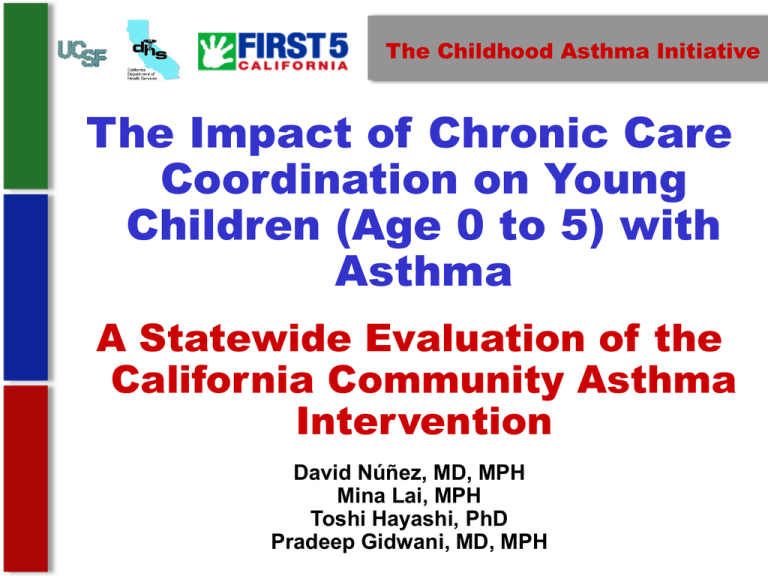The Impact of Chronic Care Coordination on Young Asthma
advertisement

The Childhood Asthma Initiative The Impact of Chronic Care Coordination on Young Children (Age 0 to 5) with Asthma A Statewide Evaluation of the California Community Asthma Intervention David Núñez, MD, MPH Mina Lai, MPH Toshi Hayashi, PhD Pradeep Gidwani, MD, MPH Asthma Statistics • Asthma affects 9 million children in the U.S. • Asthma accounts for 14.7 million missed school days and 11.8 million missed work days annually • In 2002, 4,261 deaths due to asthma; 187 children under 18 • $14 billion in asthma-related healthcare each year • 1.9 million asthma-related visits to hospital emergency departments in 2002; 727,000 for children under 18 • Children aged 0 to 4 years have the highest rates of hospitalization and ED visits for asthma Childhood Asthma Initiative First Five California established the Childhood Asthma Initiative in 2000 with Proposition 10 (tobacco tax): • For children with asthma <5 years old • In communities with greatest asthma disparities • Enrollees: 72% Latino, 14% African American, 5% Caucasian, 4% Asian/PI, 5% other Goals • Improve quality of life for children and their families • Increase access to quality health care • Decrease asthma morbidity and mortality • Decrease ER and hospitalization visits Social-Medical Model of Care Program Components • Community asthma coalitions • Asthma treatment services Outpatient clinic-based services • Community intervention services Asthma coordinator services AC Services Provided • Basic asthma education • Assess home environment & assist in implementing environmental control measures • Instruct on proper use of medications/devices • Reinforce asthma management plan • Refer to community resources • Refer to MediCal/Healthy Families/California Kids • Coordinate care with health care providers • Coordinate care with child care providers Evaluation • Pre-interview and post-interview with parents or caregivers • 1,920 out of 2,460 total enrollees had 2 interviews or more • Cochran-Mantel-Haenszel chi-square test used for analysis Evaluation (cont.) Outcome measures include: • Possession of a written asthma management plan • Hospitalizations • Emergency room visits • Childcare/preschool days, work days missed • Asthma symptoms • Quality of Life Entry interview l its vis wo rk ho sp ita ER d e pla n ch ild ca r iss e d m iss e m pt om s en t m an ag em sy m percent Outcome Measures 70 60 50 40 30 20 10 0 Last interview Care Coordination In the Home: • Use asthma coordinators • Provide in-home environmental assessment and environmental control supplies In the Community: • Collaborate with other community asthma programs, policymakers, organizations Linking the clinic, home and community: • Consistent education • Consistent communication • Consistent written asthma action plan Why does it work? • Improves communication • Addresses cultural competency • Enables parents to be more active in child’s care • Provides social support for the family and asthmatic child • Streamlines delivery of health care services



